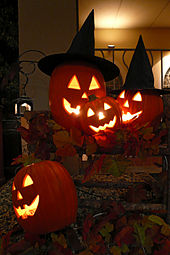A historical perspective of Halloween
History
Historian Nicholas Rogers, exploring the origins of Halloween, notes that while "some folklorists have detected its origins in the Roman feast of Pomona, the goddess of fruits and seeds, or in the festival of the dead called Parentalia, it is more typically linked to the Celtic festival of Samhain, whose original spelling was Samuin (pronounced sow-an or sow-in)". [1] The name is derived from Old Irish and means roughly "summer's end". [1] A similar festival was held by the ancient Britons and is known as Calan Gaeaf (pronounced Kálan Gái av).
 Snap-Apple Night by Daniel Maclise showing a Halloween party in Blarney, Ireland, in 1832. The young children on the right bob for apples. A couple in the center play a variant, which involves retrieving an apple hanging from a string. The couples at left play divination games.
Snap-Apple Night by Daniel Maclise showing a Halloween party in Blarney, Ireland, in 1832. The young children on the right bob for apples. A couple in the center play a variant, which involves retrieving an apple hanging from a string. The couples at left play divination games.
The festival of Samhain celebrates the end of the "lighter half" of the year and beginning of the "darker half", and is sometimes [2] regarded as the "Celtic New Year". [3]
The ancient Celts believed that the border between this world and the Otherworld became thin on Samhain, allowing spirits (both harmless and harmful) to pass through. The family's ancestors were honoured and invited home while harmful spirits were warded off. It is believed that the need to ward off harmful spirits led to the wearing of costumes and masks. Their purpose was to disguise oneself as a harmful spirit and thus avoid harm. In Scotland the spirits were impersonated by young men dressed in white with masked, veiled or blackened faces. [4] [5] Samhain was also a time to take stock of food supplies and slaughter livestock for winter stores. Bonfires played a large part in the festivities. All other fires were doused and each home lit their hearth from the bonfire. The bones of slaughtered livestock were cast into its flames. [6] Sometimes two bonfires would be built side-by-side, and people and their livestock would walk between them as a cleansing ritual.
Another common practice was divination, which often involved the use of food and drink.
The name 'Halloween' and many of its present-day traditions derive from the Old English era. [7] [8] [9]
Origin of name
The word Halloween is first attested in the 16th century and represents a Scottish variant of the fuller All-Hallows-Even ("evening"), that is, the night before All Hallows Day. Up through the early 20th century, [citation needed] the spelling "Hallowe'en" was frequently used, eliding the "v" and shortening the word. Although the phrase All Hallows is found in Old English (ealra halgena mæssedæg, mass-day of all saints), All-Hallows-Even is itself not attested until 1556. [10]
Symbols

 Jack-o'-lanterns in Kobe, Japan
Jack-o'-lanterns in Kobe, Japan
Development of artifacts and symbols associated with Halloween formed over time encompassing customs of medieval holy days as well as contemporary cultures. The souling practice of commemorating the souls in purgatory with candle lanterns carved from turnips, became adapted into the making of jack-o'-lanterns. [11] In traditional Celtic Halloween festivals, large turnips were hollowed out, carved with faces, and placed in windows to ward off evil spirits. [5] The carving of pumpkins is associated with Halloween in North America where pumpkins are both readily available and much larger – making them easier to carve than turnips. [12] Many families that celebrate Halloween carve a pumpkin into a frightening or comical face and place it on their doorstep after dark. The American tradition of carving pumpkins preceded the Great Famine period of Irish immigration [13] and was originally associated with harvest time in general, not becoming specifically associated with Halloween until the mid-to-late 19th century. [14] [15]
The imagery of Halloween is derived from many sources, including national customs, works of Gothic and horror literature (such as the novels Frankenstein and Dracula), and classic horror films (such as Frankenstein and The Mummy). [16] Elements of the autumn season, such as pumpkins, corn husks, and scarecrows, are also prevalent. Homes are often decorated with these types of symbols around Halloween.
Halloween imagery includes themes of death, evil, the occult, magic, or mythical monsters. [17] Traditional characters include ghosts, witches, skeletons, vampires, werewolves, demons, bats, spiders, and black cats. [18] Black and orange are the traditional Halloween colors and represent the darkness of night and the color of bonfires, autumn leaves, and jack-o'-lanterns. [18]

